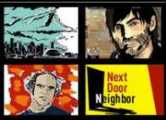SMITH Diaries: Back In New Orleans
April 21st, 2006 by Tim BarkowChapter 2: Life on the Strip in the New Normal
Check out Chapter 1 here.
On the eve of the historic mayoral election, our correspondent still isn’t sure which way she’s swinging, but says it takes more than a flood to break the spirit of the cats in her many hats.
By Cree McCree
Cree McCree left New York for NOLA in August, 2001, escaped NOLA during the flood, has returned, where she has picked up her life as a flea market entrepreneur, costumier, and assemblage artist. She is a contributing editor at High Times magazine and a frequent contributor to Offbeat.com.
MARDIS GRAS HAS COME AND GONE, along with the St. Patrick’s Day parade (both Uptown and Downtown versions), the Italian parade, the Irish-Italian parade, the towering food altars of St. Joseph’s Day, and a scaled-down version of the Mardi Gras Indians’ annual St. Joseph walkabout. So for a brief period between now and the big French Quarter Fest that immediately precedes Jazzfest, things are pretty much back to (ab)normal in New Orleans, or the New Normal, as Times-Picayune columnist and rising national media star Chris Rose calls it.
For me, the New Normal is life on The Island (as Chris calls it), which I like to call The Strip: the high and dry band of land right next to the Mississippi River, stretching from the far reaches of the Bywater and Marigny through the Quarter and all the way Uptown, which for the most part escaped major flooding and remains more or less intact.
Less is the operative word, even in The Strip: Home mail delivery happens one or twice a week if you’re lucky (and no magazines at all in the still-forbidden 701 zip zones of Orleans Parish). Garbage pick-up (maybe) once a week if you’re very lucky. No recycling until probably forever (and it still feels weird throwing bottles and cans and papers away with the boiled shrimp shells). Lots of traffic lights are still out, replaced by the ubiquitous four-way stops where distracted drivers glued to their insurance adjusters on mobiles bump and grind their way to meetings with their contractors. Stores and restaurants are open but with limited hours, scaled-back menus, and skeleton staffs. Translation: you can’t make a 10pm beer run to Sav-A-Center, or get a pizza delivered from Rocky’s, or pay for breakfast with plastic at Slim’s.
But these are minor inconveniences. Our place, House of Boo (named for the cats that rule our roost) was only grazed by Katrina’s winds and not victimized by the Army Corps of Bunglers, whose man-made levee breaches flooded most of the town. We didn’t even have to toss out a moldy refrigerator to fester in the streets, thanks to the foresight of my husband, Donald — who may be the only person in New Orleans who emptied the fridge of food before evacuating. (Donald also put “Terrorist Target” high on his list of reasons to leave New York City for New Orleans, where we moved into our house on August 11, 2001. But that’s another story.)
When we came back home after two months of post-K exile in Asheville, North Carolina (which ain’t exactly the Superdome), most of the plants we’d dragged inside were dead. But our lucky “money” plant was still alive. And, more importantly, so was Tig — the outdoor cat we’d left behind, who reappeared miraculously right after I stopped searching for him online at PetFinder.com. (”Moron!” he meowed. “I’m out here, on the deck!”) Everything else was exactly the way we’d left it — not a speck of mold besmirched our artwork or Donald’s extensive collection of avant books and records or my stock of vintage clothes and costumes — which would soon help me spawn my most successful season ever as a Mardi Gras costumier.
So am I wracked with survivor guilt? You bet; though I swore off Calvinism years ago, there’s still an inner Methodist that says I don’t deserve my good fortune. But I also know that what Donald and I do — make music, make art, and keep the underground economy bubbling with flea markets and community sales — is a vital part of the recovery process. I also believe that those of us who don’t have to spend our energy gutting our houses have that much more to give to a city that’s given so much to us.
What’s astonishing is that people who are gutting their houses are right there in the trenches with us. The vast majority of my friends and fellow artists, even those who lost everything, are back in town and rebuilding their lives. There’s Brett, who made a harrowing escape from Mid-City at the height of the shoot-and-loot insanity and not only lived to tell the tale but is making it in into poetry. Wendy, a UNO communications prof who salvaged nothing from her Lakeview home and is staying sane by teaching a meta-class in post-K narratives and baking up a storm in her Uptown rental. Jimmy and Sue Ford, who gutted the first two floors of their flooded house to accommodate a home elevator for their two wheelchair-bound teenage sons, who suffer from muscular dystrophy — and didn’t let the heavy labor slow them down. Sue still rocked the Muses parade as the leader of the all-girl Mardi Gras band Pink Slip, Jimmy still served as Grand Marshal for the Lyons Marching Club, and the Fords still hosted a Mardi Gras bash for out-of-town friends in their new, vastly improved digs. That’s the thing about rebuilding; as long as you gotta do it, you might as well do it right.
“Everyone has a story” is true to the nth power in post-K New Orleans, and I’m going to try to bring you as many of those stories as possible as the weeks and the months go on, along with my personal take on the bigger picture. With so much at stake here, the big picture really does matter.
And I still don’t know who is getting my vote for mayor.
Next chapter: The harrowing misadventures of Mid-City poet Brett Evans and his fellow “Cavalier Assholes,” who were too hungover to evacuate … and got swept into Waterworld.
Previously: Check out Chapter 1 here.




